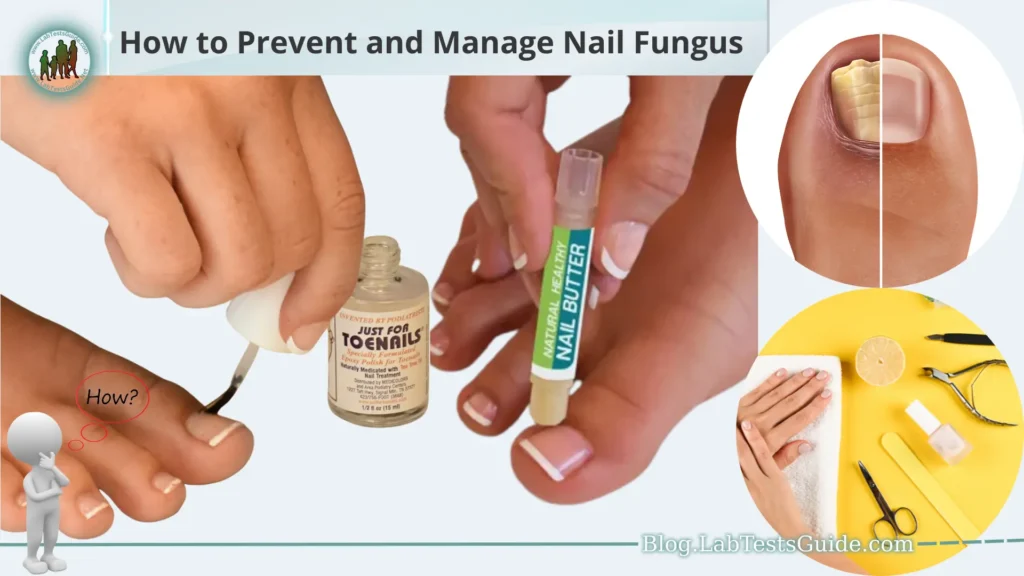Nail fungus, medically known as onychomycosis, is a common and persistent condition that affects millions of people worldwide. It occurs when fungi, such as dermatophytes or yeasts, invade and thrive in the nails, leading to discoloration, thickening, and brittleness. While it is not life-threatening, nail fungus can cause discomfort, embarrassment, and even affect one’s self-esteem. Prevention and proper management of nail fungus are crucial to avoid its spread, alleviate symptoms, and promote healthier nails.

In this comprehensive guide, we will explore various strategies to prevent and manage nail fungus effectively. We’ll delve into the causes and risk factors associated with this condition, empowering you with knowledge to make informed decisions. From simple lifestyle changes and hygiene practices to over-the-counter treatments and home remedies, we’ll provide a range of approaches to suit different preferences and situations. Additionally, we’ll discuss when it’s necessary to seek professional help and how to handle recurring cases, offering valuable tips to accelerate the recovery process. Whether you’re looking to safeguard yourself from nail fungus or seeking guidance to tackle an existing infection, this guide aims to equip you with the tools to maintain healthy and beautiful nails.
What Is Nail Fungus?
- Nail fungus, also known as onychomycosis, is a common fungal infection that affects the nails, usually starting at the tips and edges.
- It is primarily caused by dermatophytes, a group of fungi that thrive in warm and moist environments, making nails an ideal breeding ground.
- The infection can also be caused by yeasts and molds.
- Nail fungus can affect both fingernails and toenails, but it is more commonly found in toenails due to the warm and damp conditions inside shoes.
- It is a contagious condition and can spread from one nail to another and even from person to person.
- The infection begins as a small white or yellow spot under the nail’s tip and can gradually spread deeper into the nail if left untreated.
- As the fungus progresses, the nail may become discolored, thickened, brittle, and crumbly.
- In severe cases, the infected nail may separate from the nail bed, causing pain and discomfort.
- People with weakened immune systems, diabetes, or poor circulation are more susceptible to nail fungus.
- Nail fungus can be persistent and challenging to eliminate completely, often requiring consistent and targeted treatments.
How to Recognize Nail Fungus:
- Discoloration: One of the early signs of nail fungus is a change in nail color. The infected nail may appear yellow, white, brown, or even greenish. The discoloration often starts at the nail’s edge and spreads towards the base as the infection progresses.
- Thickening: Infected nails tend to thicken and become abnormally bulky. As the fungus grows, it can cause the nail to lose its smooth texture and become uneven and difficult to trim.
- Brittleness and Crumbling: Nail fungus weakens the nail structure, leading to increased fragility. The infected nail may become brittle and prone to crumbling or breaking easily.
- Distorted Shape: Over time, the nail may lose its normal shape and become distorted or warped. It can become irregularly curved or raised, causing discomfort when wearing shoes.
- Separation from Nail Bed: As the fungal infection advances, the nail can separate from the nail bed. This condition, known as onycholysis, creates a gap between the nail and the skin, making the affected area more susceptible to secondary bacterial infections.
- Foul Odor: In some cases, nail fungus can produce a foul smell due to the metabolic by-products of the fungi. This odor may be noticeable, especially when the infected nail comes into contact with moisture.
- Itching or Discomfort: Nail fungus can cause itching, irritation, or mild pain around the affected nail. In advanced stages, the discomfort may increase and make daily activities more challenging.
- Spreading to Other Nails: If left untreated, nail fungus can spread to neighboring nails or even to other individuals if they come into contact with contaminated surfaces or personal items.
Understanding Nail Fungus:
Nail fungus, medically known as onychomycosis, is a prevalent fungal infection that affects the nails of both fingers and toes. It is caused by various types of fungi, such as dermatophytes, yeasts, and molds, that thrive in warm, moist environments. While nail fungus is generally not a serious health concern, it can lead to discomfort, cosmetic issues, and potential complications if left untreated.
Causes:
- Dermatophytes: The most common cause of nail fungus, these fungi feed on keratin, the protein found in nails and skin.
- Yeasts and Molds: Other types of fungi, such as Candida yeasts and non-dermatophyte molds, can also cause nail infections, though they are less frequent.
Risk Factors:
Several factors can increase the risk of developing nail fungus, including.
- Age: The risk increases with age, as nails become more brittle and susceptible to damage.
- Poor Circulation: Reduced blood flow to the extremities can hinder the body’s natural ability to fight off infections.
- Weakened Immune System: Conditions like HIV/AIDS or certain medications can weaken the immune system, making the body less effective at combating infections.
- Nail Injuries: Any damage to the nail, like cracks or breaks, can provide an entry point for fungi.
- Moist Environments: Fungi thrive in warm, moist environments, making places like public swimming pools, gyms, and communal showers high-risk areas for infection.
- Tight-Fitting Shoes: Shoes that don’t allow for proper ventilation can create a favorable environment for fungal growth in the toes.
Signs and Symptoms:
- Discoloration: The infected nail may change color, usually becoming yellow, white, brown, or greenish.
- Thickening: Infected nails often become thicker and difficult to trim.
- Brittleness and Crumbling: The infected nail may become brittle and crumbly, leading to pieces breaking off.
- Distorted Shape: As the fungus progresses, the nail’s shape may become irregular or distorted.
- Separation from Nail Bed: The nail can separate from the nail bed, causing pain and discomfort.
- Foul Odor: In some cases, nail fungus can produce a foul smell.
- Itching or Discomfort: The affected area may itch or cause mild pain.
Preventive Measures:
Personal Hygiene Tips:
- Keep your hands and feet clean and dry throughout the day, especially after washing or being in water.
- Regularly wash your hands and feet with soap and water, ensuring to clean the spaces between your toes and fingers.
- Thoroughly dry your feet, including the areas between the toes, using a clean towel after bathing or swimming.
Proper Nail Care:
- Trim your nails regularly and keep them short to reduce the risk of debris accumulation and fungal growth.
- Use clean and sanitized nail clippers or scissors for nail grooming.
- Avoid biting or picking at the nails, as it can damage the nail structure and create entry points for fungi.
Choosing the Right Footwear:
- Wear moisture-wicking socks that help keep your feet dry by absorbing sweat.
- Opt for breathable shoes made of materials like leather or mesh to allow proper air circulation around your feet.
- Avoid wearing tight-fitting shoes or high heels for extended periods, as they can create a warm and damp environment that encourages fungal growth.
Avoiding High-Risk Areas:
- Be cautious in public places with communal bathing areas, such as swimming pools, saunas, and locker rooms. Wear flip-flops or shower shoes to reduce contact with potentially contaminated surfaces.
- If you visit nail salons, ensure they follow proper hygiene practices, such as sanitizing tools between clients and using disposable items when possible.
Proper Footwear Hygiene:
- Rotate your shoes to allow them to dry completely between uses, as fungi thrive in damp environments.
- Consider using antifungal sprays or powders inside your shoes to prevent fungal growth.
Maintain a Healthy Immune System:
- Adopt a balanced diet rich in vitamins and minerals to support your immune system’s ability to fight off infections.
- Engage in regular physical activity to boost overall health and circulation.
- Avoid Sharing Personal Items: Refrain from sharing socks, shoes, nail clippers, and other personal items that may come into contact with infected nails.
Lifestyle and Dietary Changes:
Strengthening the Immune System:
- Engage in regular physical activity and maintain a healthy weight to support a robust immune system.
- Get adequate sleep each night, as rest is essential for immune function and overall well-being.
- Manage stress through relaxation techniques, meditation, or hobbies that bring joy and calmness.
Balancing Diet for Nail Health:
- Include a variety of nutrient-rich foods in your diet, such as fruits, vegetables, whole grains, lean proteins, and healthy fats.
- Consume foods rich in biotin, such as eggs, nuts, seeds, and sweet potatoes, as biotin is essential for healthy nail growth.
- Ensure an adequate intake of vitamins and minerals, particularly vitamin C, vitamin E, zinc, and iron, which contribute to nail strength and health.
Supplements for Nail Fungus Prevention:
- Consult with a healthcare professional before taking any supplements, especially those marketed for nail health or antifungal properties.
- Some individuals may benefit from supplements containing biotin, folic acid, or specific vitamins and minerals to support nail health.
Avoiding Harmful Habits:
- Refrain from smoking, as smoking can impair blood circulation and reduce the body’s ability to fight infections effectively.
- Limit alcohol consumption, as excessive alcohol intake can weaken the immune system and affect overall health.
- Wearing Breathable Fabrics: Choose clothing made of breathable fabrics to promote air circulation and reduce sweat retention, which can create a favorable environment for fungal growth.
Regular Exercise and Foot Care:
- Engage in physical activities that promote blood circulation, as improved blood flow can aid in preventing fungal infections.
- Practice good foot hygiene, such as washing and thoroughly drying your feet after exercise or being in sweaty environments.
- Limiting Sugar Intake: High sugar consumption can weaken the immune system and promote fungal growth. Reduce your intake of sugary foods and beverages to support overall health.
Environmental Tips:
Keeping Surroundings Clean and Dry:
- Regularly clean and disinfect surfaces that come into contact with your feet, such as bathroom floors, shower areas, and bath mats.
- Ensure proper ventilation in areas prone to moisture, like bathrooms, to prevent fungal growth.
Disinfecting Nail Tools:
- If you use nail clippers, files, or other nail grooming tools, make sure to clean and sanitize them after each use.
- Use a disinfectant solution or rubbing alcohol to sterilize the tools and prevent the transfer of fungi.
Using Antifungal Sprays:
- Consider using antifungal sprays on your feet and inside your shoes to create an inhospitable environment for fungi.
- Antifungal sprays can help reduce the risk of fungal growth and reinfection.
Avoiding Sharing Personal Items:
- Refrain from sharing towels, socks, shoes, or any personal items that may come into contact with your feet or nails.
- Sharing such items can facilitate the spread of fungi between individuals.
Regularly Changing Socks and Shoes:
- Change your socks daily, especially if your feet tend to sweat excessively.
- Avoid wearing the same pair of shoes every day; allowing them to air out between uses can help prevent fungal growth.
- Washing Beddings and Towels: Regularly wash and dry your beddings, towels, and socks in hot water to kill any fungal spores and prevent reinfection.
Properly Cleaning Footwear:
- Regularly clean and disinfect the insides of your shoes, especially if you’ve had a fungal infection before.
- Consider using antifungal powders or sprays inside your shoes to keep them fungus-free.
- Avoiding Walking Barefoot in Public Places: Wear sandals or flip-flops in public places like swimming pools, locker rooms, and communal showers to reduce the risk of coming into contact with fungi.
Over-the-Counter Treatments:
Topical Antifungal Creams and Ointments:
- Over-the-counter antifungal creams containing ingredients like clotrimazole, miconazole, or terbinafine can be applied directly to the affected nail and surrounding skin.
- Follow the product’s instructions for application frequency and duration of use.
Medicated Nail Polish:
- Antifungal nail polishes are available without a prescription and can be applied directly to the infected nail.
- These polishes often contain antifungal agents like ciclopirox, which helps combat the fungus.
Antifungal Nail Serums:
- Some nail serums are formulated with antifungal properties and are designed to penetrate the nail plate for deeper treatment.
- They often come in a brush-on applicator, allowing easy application to the infected nails.
Antifungal Nail Gels:
- Antifungal nail gels can provide a thicker and more adhesive treatment option compared to creams or serums.
- The gel is applied to the infected nail, and it adheres well, allowing the active ingredients to remain in contact with the nail for a more extended period.
Antifungal Nail Solution:
- Antifungal nail solutions are typically packaged in a small bottle with an applicator brush.
- The solution is applied directly to the infected nail and surrounding skin.
Combination Kits:
- Some over-the-counter products come in kits that include a combination of antifungal treatments, such as creams, files, and brushes, for a comprehensive approach to treatment.
Home Remedies:
Tea Tree Oil:
- Tea tree oil is a natural antifungal agent and can be applied topically to the affected nail.
- Mix a few drops of tea tree oil with a carrier oil, such as coconut or olive oil, and apply it to the infected nail using a cotton ball or swab.
- Repeat this process once or twice daily until the infection improves.
Vinegar Soaks:
- Vinegar has acidic properties that can help create an unfavorable environment for fungi.
- Prepare a foot soak by mixing equal parts of white vinegar and warm water in a basin.
- Soak your feet in the solution for 15-20 minutes daily.
- Pat your feet dry thoroughly after the soak.
Baking Soda Paste:
- Baking soda can help control fungal growth and reduce moisture.
- Make a paste by mixing baking soda with a small amount of water.
- Apply the paste to the infected nail and leave it on for about 10 minutes before rinsing off with water.
- Repeat this process once daily.
Garlic:
- Garlic has antifungal properties that can be beneficial in combating nail fungus.
- Crush a few garlic cloves to form a paste and apply it directly to the affected nail.
- Cover the nail with a bandage and leave it on for several hours or overnight.
- Repeat this treatment daily until you see improvement.
Listerine Soak:
- Listerine mouthwash contains ingredients like menthol, thymol, and eucalyptol, which have antifungal properties.
- Create a foot soak by diluting Listerine with equal parts of water in a basin.
- Soak your feet in the solution for about 30 minutes daily.
Oregano Oil:
- Oregano oil is another natural antifungal remedy.
- Mix a few drops of oregano oil with a carrier oil and apply it to the affected nail using a cotton ball or swab.
- Leave it on for 30 minutes before rinsing off.
FAQs:
What is nail fungus, and how does it develop?
Nail fungus, or onychomycosis, is a fungal infection that affects the nails of both fingers and toes. It develops when fungi, such as dermatophytes or yeasts, invade and thrive in the nails, usually due to warm and moist environments.
What are the common signs and symptoms of nail fungus?
Common signs of nail fungus include nail discoloration (yellow, white, brown, or greenish), thickening of the nail, brittleness, distorted shape, separation from the nail bed, foul odor, and sometimes mild pain or itching.
How can I prevent nail fungus from developing?
To prevent nail fungus, practice good personal hygiene, keep your feet clean and dry, choose breathable footwear, avoid sharing personal items, and maintain a healthy immune system.
Can nail fungus spread to other nails or to other people?
Yes, nail fungus can spread from one nail to another on the same individual and even to other people through direct contact or sharing contaminated items.
What are the available over-the-counter treatments for nail fungus?
Over-the-counter treatments for nail fungus include topical antifungal creams, medicated nail polish, antifungal nail serums, antifungal nail gels, antifungal nail solutions, and combination kits.
Are there any home remedies that can help manage nail fungus?
Yes, some home remedies may help manage nail fungus, such as using tea tree oil, vinegar soaks, baking soda paste, garlic, Listerine soaks, and oregano oil. However, home remedies may not be as effective as medical treatments, especially for severe infections.
When should I consult a healthcare professional about nail fungus?
It’s advisable to seek professional advice if you suspect you have nail fungus, experience persistent symptoms, have underlying health conditions, or if over-the-counter treatments and home remedies don’t yield results.
Can I prevent nail fungus if I frequently visit public places like swimming pools or gyms?
While it’s challenging to completely eliminate the risk, you can reduce the chances of infection by wearing flip-flops or shower shoes in public places, avoiding direct contact with contaminated surfaces, and practicing good foot hygiene.
How long does it take to treat nail fungus effectively?
Nail fungus treatment can be a gradual process and may take several weeks or even months to see significant improvement. Consistency in following the prescribed treatments is essential for successful management.
Are there any lifestyle changes I can make to help prevent nail fungus?
Yes, maintaining a balanced diet, strengthening your immune system, avoiding harmful habits like smoking, and wearing breathable fabrics can all contribute to overall nail health and lower the risk of nail fungus.
Conclusion:
In conclusion, nail fungus, or onychomycosis, is a common and persistent fungal infection that can affect the nails of both fingers and toes. While it is not life-threatening, its impact on self-esteem, discomfort, and potential complications necessitate preventive measures and proper management. By practicing good personal hygiene, maintaining healthy lifestyle habits, and being mindful of environmental factors, one can significantly reduce the risk of developing nail fungus. Over-the-counter treatments and home remedies can offer additional support, especially in milder cases. However, for severe or persistent infections, seeking professional advice and medical treatments from a healthcare provider remains crucial for effective management. With a comprehensive approach and dedication to nail health, individuals can better protect themselves and promote healthier, beautiful nails.






